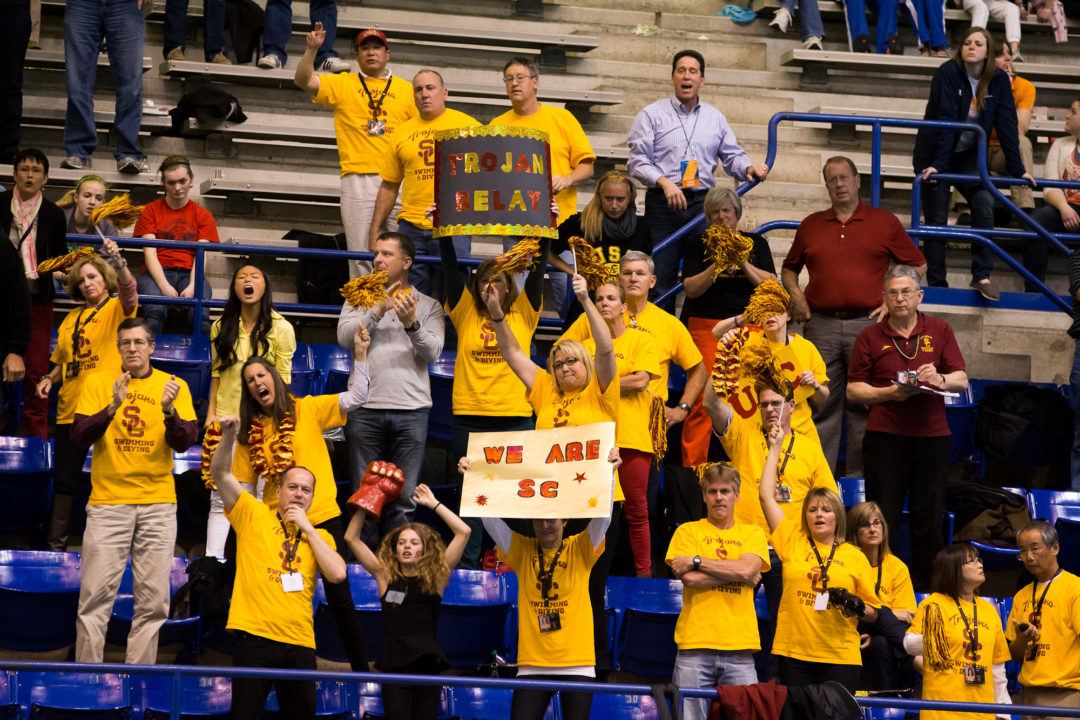Though we’re not DiveDove, we do dabble in diving coverage, and as diving can have a major impact on the NCAA Swimming & Diving Championships, we cover NCAA Zone Diving – mainly through the lens of how national diving qualifiers could impact the team points battles later this month.
2021 NCAA Zone Diving
- Zone A: Greensboro Aquatic Center / Greensboro, NC
- Thursday, March 11 – Saturday, March 13
- Live Results
- Zone B: Greensboro Aquatic Center / Greensboro, NC
- Sunday, March 7 – Tuesday, March 9
- Live Results
- Zone C: University of Kentucky / Lexington, KY
- Sunday, March 7 – Tuesday, March 9
- Live Results
- Zone D: University of Kentucky / Lexington, KY
- Thursday, March 11 – Saturday, March 13
- Live Results
- Zone E: Northern Arizona University / Flagstaff, AZ
- Monday, March 8 – Wednesday, March 10
- Live Results
USC sophomore Georgii Korovin won the men’s platform event on day 2, with few new qualifiers but more top divers adding second NCAA events.
Korovin was third on 3-meter to open the meet, and blew out the platform field by a whopping 67 points on day 2. He’s locked into NCAAs in both events, with 1-meter still to come.
Most of the top names added platform as a second event after qualifying through 3-meter a day earlier. That includes Stanford’s Noah Vigran and Arizona’s duo of Bjorn Markentin and Eric Correa.
On the women’s side, Hawaii’s Daphne Wils picked up the win on 3-meter to nab the top priority NCAA invite for the meet. Wils beat San Diego State’s Ximena Lechuga Gonzalez by about twelve points.
Stanford’s Mia Paulsen added 3-meter as a second qualifying event, but Daria Lenz did not, falling to 14th overall and missing the cut line by about seven points.
USC got a second woman into NCAAs: Savannah Stocker was fifth on 3-meter, and Nike Agunbiade added 3-meter as a second NCAA event.
Current Qualifiers
Reimbursed divers are in bold, with invited-but-not-reimbursed divers in non-bold. You can read more about the distinction below.
| Women | |
| Diver | Events |
| Daphne Wils, Hawaii | 1m, 3m |
| Delaney Schnell, Arizona | 1m |
| Ximena Lechuga Gonzalez, SDSU | 1m, 3m |
| Mia Paulsen, Stanford | 1m, 3m |
| Melissa Mirafuentes, Wyoming | 1m, 3m |
| Hannah Butler, UCLA | 1m, 3m |
| Savannah Stocker, USC | 3m |
| Daria Lenz, Stanford | 1m |
| Nike Agunbiade, USC | 1m, 3m |
| Montse Urzua, UNLV | 3m |
| Gracie Sleeman, Arizona | 3m |
| Briana Thai, Cal | 1m, 3m |
| Lizzy de Cocco, Utah | 1m |
| Kennedy Cribbs, BYU | 1m |
| Emma Ruchala, Utah | 1m, 3m |
| Men | |
| Diver | Events |
| Conor Casey, Stanford | 3m |
| Georgii Korovin, USC | 3m, Pl |
| Noah Vigran, Stanford | 3m, Pl |
| Luke McDivitt, Utah | 3m, Pl |
| Bjorn Markentin, Arizona | 3m, Pl |
| Tony Chen, Utah | 3m |
| Eric Correa, Arizona | 3m, Pl |
| Zachory Lundgren, Hawaii | Pl |
| Mickey Strauss, BYU | 3m, Pl |
| Max Burman, Hawaii | 3m |
SIMPLIFIED INVITE PROCEDURES
You can read a more in-depth look at the selection process here. Effectively, each Zone earns a specific number of qualifying spots in each event, based on how that Zone performed at NCAAs last year. Divers who place inside the qualifying places earn an NCAA invite. A diver invited in one event can compete at NCAAs in any other diving event where they were top 12 in their Zone meet. The highest-placing divers earn NCAA reimbursement, while lower-placing qualifiers can compete at NCAAs, but their school must pay for their travel and lodging at the meet.
